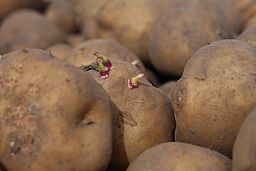Amflora facts for kids
Quick facts for kids Amflora |
|
|---|---|
 |
|
| Event | EH92-527-1 |
| Identifier(s) | BPS-25271-9 |
| Plant | Solanum tuberosum L. |
| Mode | Transgenesis |
| Method | Insertion |
| Vector | pHoxwG |
| Developer | Svalöf Weibull AB |
| Trait(s) conferred | Decreased amylose production, increased kanamycin resistance |
| Genes introduced | Granule bound starch synthase, neomycin phosphotransferase II |
Amflora (also known as EH92-527-1) is a special type of potato. It was created using genetic modification by a company called BASF Plant Science. This potato was designed to produce a very pure kind of starch called amylopectin. This specific starch is very useful for different industries.
The Amflora potato was approved for industrial use in the European Union in March 2010. However, in January 2012, it was taken off the market in the EU.
Contents
History of Amflora
The Amflora potato was first registered in 1996. It was developed by two scientists, Lennart Erjefält and Jüri Känno, from a company called Svalöf Weibull AB.
After the European Commission approved the potato, BASF planned to grow Amflora seeds. They started planting in Germany and Sweden in April 2010. They also planted some in the Czech Republic for business purposes.
However, many people in Europe were not keen on GM crops. Because of this, BASF Plant Science decided in 2012 to stop selling Amflora in Europe. They continued to seek approval for their products in other parts of the world, like the Americas and Asia.
In 2013, a court in the EU decided that the approval of Amflora in 2010 was not done correctly. They said the EU Commission had broken some rules.
How Amflora Works
Regular potatoes produce two main types of starch: amylose and amylopectin. Amylopectin is the type that is most useful for industrial uses.
The Amflora potato was changed so it would make almost only amylopectin. Scientists did this by using genetic engineering. They turned off the gene that tells the potato to make amylose. This means the Amflora potato produces very little of the less useful amylose.
Industrial Uses
Potato starch is used in many industries. Regular potato starch has about 80 percent amylopectin and 20 percent amylose. Amylopectin is a better polymer for industrial uses. Amylose can sometimes cause problems and needs extra chemical changes, which can be expensive.
BASF's scientists worked for twenty years to create the Amflora potato. By turning off the gene for amylose, they made a potato that produces mostly amylopectin.
Amflora potatoes were meant to be processed into starch. This starch would then be sold to industries that need pure amylopectin. Amflora was only for industrial uses, such as making paper and other technical products. Europe produces a lot of natural potato starch each year. BASF hoped Amflora would become a big part of this market.
Other Possible Uses
BASF also had plans for another use for Amflora. They wanted to use the leftover potato pulp, which is what remains after the starch is taken out, as animal feed.
Getting Approval
To be sold in the European Union, Amflora needed special approval. This approval required a lot of support from the countries in the EU. There were two rounds of voting, but neither reached the needed level of support.
Even though the votes were secret, it was reported that countries like Germany and Belgium supported Amflora. Countries like Italy, Ireland, and Austria were against it. France and Bulgaria did not vote.
Finally, Amflora received its license on March 2, 2010. After this, BASF announced they would ask for approval for more types of genetically modified potatoes, such as the "Fortuna" potato.
See also
 In Spanish: Amflora para niños
In Spanish: Amflora para niños

